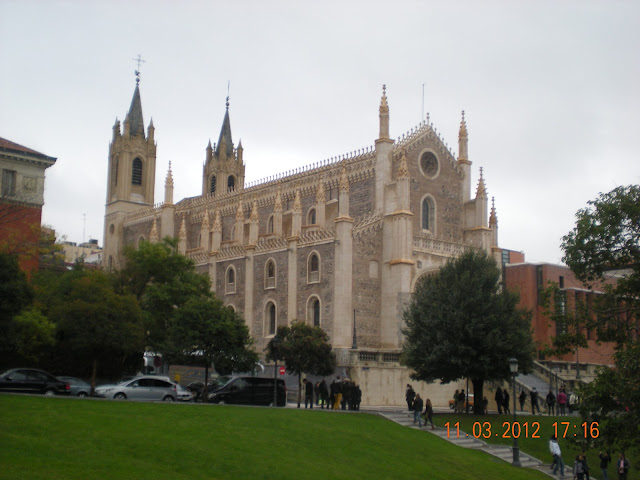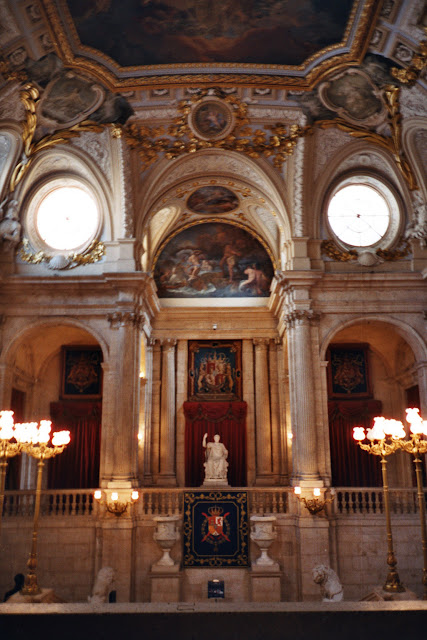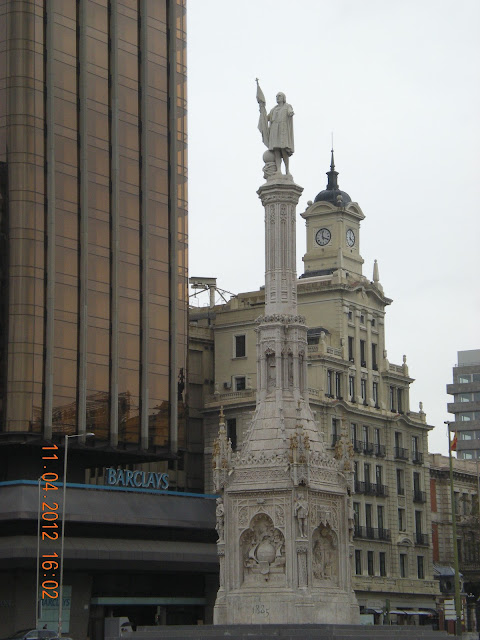We were only here for a short time as we arrived on Saturday, around noon and had to take a very early flight back to Geneva, on Monday, so Paula go to back to work.
Madrid is the capital and largest
city of Spain, with a population of roughly 3.7 million (as of December 2010). It
is the third-most populous municipality in the European Union after London and Berlin,
and its metropolitan area is the fourth-most populous urban area in the
European Union after Paris, London, and the Ruhr Area. As the capital city of
Spain, seat of government, and residence of the Spanish monarch, Madrid is also
the political center of Spain.
Due to its economic output, standard
of living, and market size, Madrid is considered the major financial center of
the Iberian Peninsula; it hosts the head offices of the vast majority of the major
Spanish companies, as well as the headquarters of three of the world's 100
largest companies (Telefónica, Repsol-YPF and Banco Santander).
While Madrid possesses a modern
infrastructure, it has preserved the look and feel of many of its historic
neighborhoods and streets. Its landmarks include the huge Royal Palace of
Madrid; the Teatro Real (Royal theatre) with its restored 1850 Opera House; the
Buen Retiro park, founded in 1631; the imposing 19th-century National Library
building (founded in 1712) containing some of Spain's historical archives; an
archaeological museum of international reputation; and three superb art
museums: Prado Museum, which hosts one of the finest art collections in the
world, the Museo Nacional Centro de Arte Reina Sofía, a museum of modern art,
and the Thyssen-Bornemisza Museum, housed in the renovated Villahermosa Palace.
Once we got settled, we headed to the Prado to spend most of Saturday afternoon.
The Museo del Prado is the main Spanish
national art museum. It features one of the world's finest collections of
European art, from the 12th century to the early 19th century, based on the
former Spanish Royal Collection, and unquestionably the best single collection
of Spanish art.
Founded as a museum of paintings and sculpture,
it also contains important collections of other types of works. A new, recently
opened wing enlarged the display area by about 400 paintings, and it is
currently used mainly for temporary expositions.
The Prado is one of the most visited sites in
the world, and it is considered to be among the greatest museums of art. The
large numbers of works by Diego Velazquez, Francisco de Goya, Titian, Rubens
and Bosch are among the highlights of the collection.
The collection currently comprises around 7,600
paintings, 1,000 sculptures, 4,800 prints and 8,200 drawings, in addition to a
large number of other works of art and historic documents. Currently, the
Museum displays about 1,300 works in the main buildings, while around
3,100 works are on temporary loan to various museums and official institutions.
The remainder is in storage.
The best-known work on display at the museum is
“Las Meninas” by Velazquez. He not only provided the Prado
with his own works, but his keen eye and sensibility was also responsible for
bringing much of the museum's fine collection of Italian masters to Spain.
Las Meninas Spanish
for “The Maids of Honour” is a 1656 painting by Diego Velazquez, the
leading Spanish painter of his time. The work's complex and enigmatic
composition raises questions about reality and illusion, and creates an
uncertain relationship between the viewer and the figures depicted. Because of
these complexities, Las Meninas has been one of the most widely analyzed
works.
The painting shows a large room in the Madrid palace
of King Philip IV of Spain, and presents several figures, most identifiable
from the Spanish court, captured, according to some commentators, in a
particular moment as if in a snapshot. Some look out of the canvas towards the
viewer, while others interact among themselves. The young Margarita, daughter
of King Philip and his wife Mariana of Austria, is surrounded by her entourage
of maids of honor, chaperon, bodyguard, two dwarfs and a dog. Just behind
them, Velazquez portrays himself working at a large canvas. Velazquez looks
outwards, beyond the pictorial space to where a viewer of the painting would
stand. In the background there is a mirror that reflects the upper bodies of
the king and queen. They appear to be placed outside the picture space in a
position similar to that of the viewer, although some scholars have speculated
that their image is a reflection from the painting Velazquez is shown working
on.
Las Meninas has long been recognized
as one of the most important paintings in Western art history. More recently, it has been described as
"Velazquez's supreme achievement, a highly self-conscious, calculated
demonstration of what painting could achieve, and perhaps the most searching
comment ever made on the possibilities of the easel painting"
Pictured below, according to the curator of the Prado, are some of their best paintings.
The Third of May 1808, by Francisco Goya (1814).
In this work, Goya sought to commemorate Spanish resistance to Napoleon's armies during the occupation of 1808.
Portrait of a Cardinal, by Raphael (1510).
The Cardinal has been identified as either
Alidosi, Bibbiena, Cybo or Trivulzio, in the court of Pope Julius II.
The Surrender of Breda, by Diego Velazquez, (1634-1635).
While visiting Italy with Ambrogio Spinola, the
Italian general who, on June 5, 1625, conquered Breda, (a city in the southern
part of the Netherlands), was inspired to paint this picture. It is considered
one of Velazquez's best artworks.
The Immaculate Conception, by Giambattista Tiepolo (1767-1768).
The Annunciation, by Fra Angelico (1430-1432).
The Crucifixion, by Juan de Flanders (1509).
In January 2012 the museum announced that it
had discovered an almost fully restored a copy of the Mona Lisa, produced by a
pupil of Leonardo da Vinci, who quite possibly painted it while working alongside the master.
San Jerónimo el Real
(St. Jerome Royal Church) is a
Roman Catholic Church from the early 16th-century, located in central
Madrid, near the Prado.
The church, which has undergone numerous
remodelings and restorations over the centuries is the remaining structure of
the Saint Jerome monastery that once stood beside the Royal Palace of Buen
Retiro, of which a portion now serves as the Prado museum. Its proximity to the
Royal Palace also underscores a connection to royalty, serving for centuries as
the church used for the swearing in of the Spanish parliaments and the kings
and queens of Spain, the latest being King Juan Carlos I, sworn in on Nov. 22, 1975.
The main alter in Saint Jerome's
The plaza is a landmark of Madrid and it is famous
for the Cibeles Palace (City Hall), seen above and the fountain of the same
name, next picture.
The most prominent of the buildings at the
Plaza de Cibeles is the Cibeles Palace (formerly named Communications Palace).
This cathedral-like landmark was built in 1909 as the headquarters of the postal service. This impressive building was home to
the Postal and Telegraphic Museum until 2007 when the landmark building became
the City Hall.
Cibeles Fountain
This fountain, named after Cybele (or Ceres),
Roman goddess of fertility, is seen as one of Madrid's most important symbols.
The Cibeles fountain depicts the goddess, sitting on a chariot pulled by two lions.
The fountain was built between 1777 and 1782 during the reign of Charles III.
A statue of King Felipe IV.
Taking center stage of Plaza de Oriente, in front of the Royal Palace, is a huge statue of King Felipe IV (who reigned from 1621 to 1640) astride a horse that was modeled from an art piece by Velaquez.
Its designer, Pietro Tacca, was afraid that the rearing horse could not be balanced properly, and that it would fall forward under its own weight. The famous Italian astronomer, Galileo Galilei, came to his rescue by suggesting that the front rearing part of the sculpture should be hollow, and therefore relatively light, with the back part solid to anchor the weight.
Palacio Real de
Madrid (The Royal
Palace of Madrid).
The Palace is the official residence of the
Spanish Royal Family in the city of Madrid, but it is only used for
state ceremonies. King Juan Carlos and the Royal Family do
not reside in the palace, choosing instead the more modest Palacio de la
Zarzuela (Zarzuela Palace) on the outskirts of Madrid.
The palace is on the site of a 9th-century
fortress, called mayrit, constructed as an outpost by Muhammad I of
Cordoba and inherited after 1036 by the independent Moorish Taifa of Toledo. After Madrid fell to Alfonso
VI of Castile in 1085, the palace was only rarely used by the kings of Castile.
Philip II moved his court to Madrid in 1561.
The palace burned down on December 24, 1734;
King Philip V ordered a new palace built on the same
location. Construction spanned the years 1738 to 1755.The new palace was occupied by Charles III in
1764. The last monarch who lived continuously in the palace was Alfonso XIII,
who reigned from 1886 to 1931.
The palace has 1,450,000 sq ft of floor
space and contains 3,418 rooms. It
is the largest palace in Europe by floor area. The interior of the palace is
notable for its wealth of art, in regards to the use of all kinds of fine
materials in its construction and the decoration of its rooms with artwork of
all kinds, including paintings by artists such as Caravaggio, Velazquez, Goya
and numerous frescoes. Other collections of great historical and artistic
importance that are preserved in the building are the Royal Armory, Porcelain,
Watches, Furniture and Silverware.
Another picture of the palace from the inner court yard.
The Grand Staircase that leads to the second floor of the Palace.
The Throne Room.
The State Dining Room. In 1885 King Alfonso XII had three of the palace's rooms converted to one large dining room with a large ball room for entertaining. Currently shown with 142 chairs, but room for many more.
The Royal Chapel.
A view of Santa
Maria la Real de La Almudena (Almudena Cathedral), a Catholic cathedral, from the inner court yard of the Royal Palace.
When the capital of Spain was transferred from
Toledo to Madrid in 1561, the seat of the Church in Spain remained in Toledo;
so the new capital, unusually for a Catholic country, did not have a cathedral. Plans
were discussed as early as the 16th century to build a cathedral in Madrid
dedicated to the Virgin of Almudena (an icon of the Virgin Mary, the patroness of Madrid),
but construction did not begin until 1879.
Construction ceased completely during the
Spanish Civil War, and the project was abandoned until 1950. The cathedral was
not completed until 1993, when it was consecrated by Pope John Paul II.
The Virgin of Almudena.
Another legend is that as Christian Soldiers approached the town, they had a vision of Mary imploring them to allow her to lead them into the city. Again the miraculous crumbling of the wall
The main alter of Santa Maria la Real de La Almudena.
After we completed our visit to the Royal Palace and The Almudena Cathedral, we decided to visit the El Rastro de Madrid
or simply El Rastro, which is the most popular open-air flea market in Madrid. El Rastro means "the trail".
The market probably owes its name to the tanneries that were once located in Ribera
de Curtidores (Ribera de Curtidores means “riverside of tanners”). Close by, on the banks of the Manzanares
River, was a slaughterhouse. Transporting the slaughtered cattle from the slaughterhouse
to the tannery left a trail (rastro) of blood along the street.
The market had its beginnings in the
fifteenth century, El Rastro has been evolving and growing, while its existence
has been regulated by the local government. A maximum of 3,500 stalls are set-up every Sunday and public
holidays, from 9:00am to 3:00pm, during the year. A great variety of products (new and
used) can be found at the market.
Today there is no travel guide about
Madrid which doesn’t mention El Rastro, and its international reputation is
comparable to other popular markets in several European cities like
Waterlooplein in Amsterdam, the Portobello market in London or the Porta Portese
in Rome.
While visiting El Rastro, we saw this bronze sculpture in Plaza Campillo Mundo Nuevo (New World Square Campillo).
It was sculptured by German sculptor Knipp to represent
the needs and social responsibility towards the protection of children.
The Puerta de Alcala or Alcala Gate.
In the middle of the busy Plaza de la
Independencia (Independence Square) stands one of Madrid's best known landmarks, the Puerta de Alcala.
Madrid in the late 18th century, still remained
a somewhat drab villa in appearance, surrounded by medieval walls. So, in
1764 King Carlos III commissioned the Italian architect Sabatini, to construct
a large gate to replace a small 16th century baroque gate, built by King
Philips III. Carlos III felt the gate, which marked the eastern boundary of the
city, was too small for the important gateway to Aragon.
Sabatini's design called for a neoclassical
granite gate with three large archways and two smaller, rectangular
passageways. Each of the archways is decorated with a lion's head, sculpted by
Roberto Michel. The top of the gate is decorated with statues by Francisco
Guttierrez.
Construction of the gate took 9 years, it was
finally completed in 1778. The gate soon became one of Madrid's symbols. It is
now classified as a national monument.
Statue of Christopher Columbus.
This statue, standing over 70 ft. high, is
located in the Plaza de Colon. In
Spain, Christopher Columbus is known as Cristobal Colon.
It was erected in 1885 to commemorate the
forthcoming 400th anniversary of Columbus' voyage to the West Indies and
features an ornamental square base with a long column above, on top of which is
a statue of Christopher Columbus. The figure is standing, looking west with an
outstretched left arm, pointing the way to the New World of the Americas.
Thus, we ended our short trip to Madrid. If time permits, we would like to return to the city.



























No comments:
Post a Comment